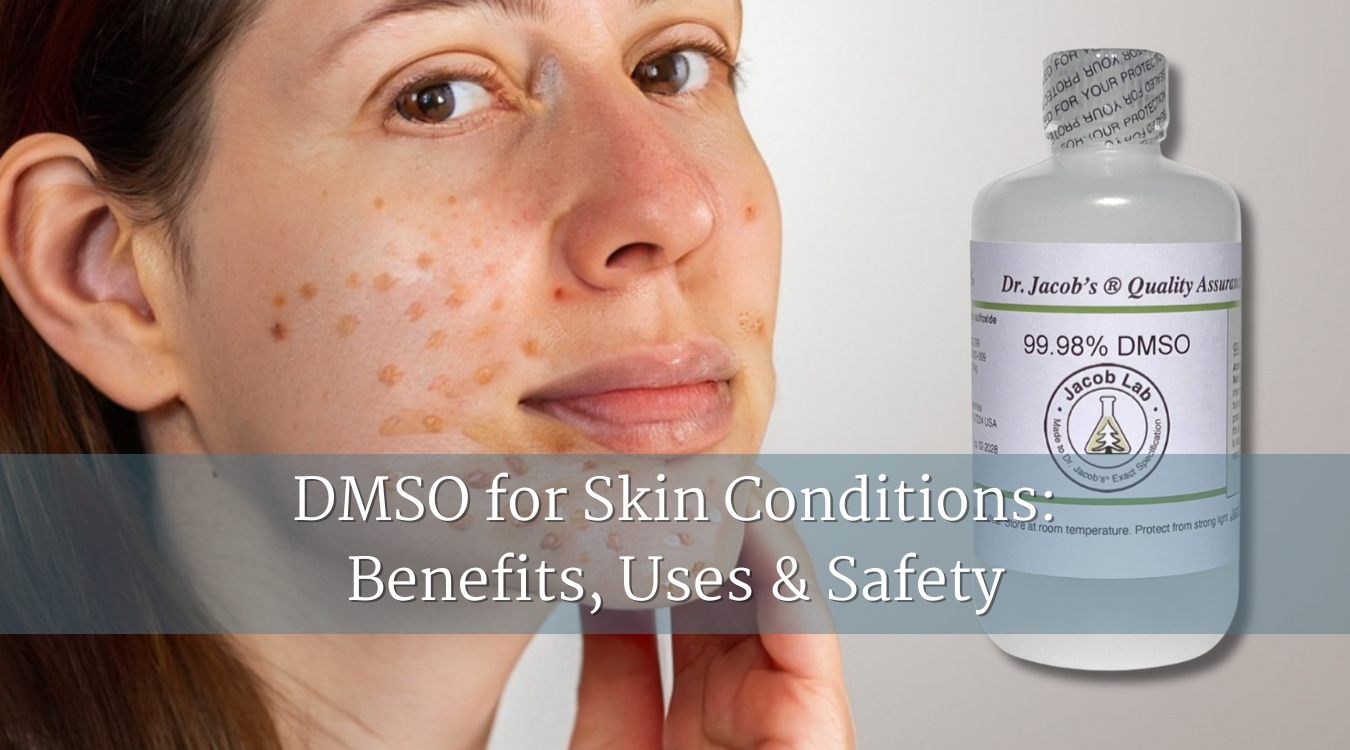
What DMSO is, how it interacts with skin, research evidence, safety considerations, FAQs
Skin is the body’s largest organ, and when it’s irritated, inflamed, or damaged, it can affect both comfort and confidence. While moisturisers and topical creams are the usual go-to, some people are turning to DMSO (dimethyl sulfoxide) as an alternative or complementary option.
DMSO is best known as a powerful solvent and anti-inflammatory compound, but it’s also being explored for its potential benefits in certain skin conditions. In this article, we’ll look at what the science says, which issues it may help, how it’s used, and what safety precautions to keep in mind.
What is DMSO?
DMSO is an organic compound derived from wood pulp, recognised for its exceptional ability to penetrate skin and carry other substances into the body. This property makes it useful in medicine, research, and veterinary care.
While it’s approved in the UK for certain non-medical uses, its application for skin conditions is still considered off-label and should be approached with care.
Why DMSO is of Interest for Skin Health
There are three main reasons DMSO gets attention for skin-related issues:
-
Anti-inflammatory effects – It may help reduce redness, swelling, and irritation.
-
Antioxidant properties – DMSO can neutralise free radicals, which contribute to skin cell damage.
-
Carrier ability – It can enhance the absorption of beneficial ingredients like aloe vera, essential oils, or certain medications.
Skin Conditions Studied with DMSO
1. Scleroderma
One of the most researched skin-related uses for DMSO is scleroderma — a rare autoimmune condition that causes skin thickening and tightening.
Some small studies and patient reports have found that applying DMSO gel or cream can soften the skin and reduce discomfort, although it is not a cure.
2. Eczema & Dermatitis
Inflammatory skin conditions like eczema can cause intense itching and redness. DMSO’s anti-inflammatory action has shown potential to ease symptoms, particularly when combined with moisturising agents. However, the risk of irritation means it must be used in very low concentrations.
3. Psoriasis
Psoriasis involves an overproduction of skin cells and chronic inflammation. DMSO may help by reducing inflammation and aiding the penetration of active treatments like vitamin D creams.
4. Wound Healing
DMSO’s ability to increase blood flow and reduce inflammation has led researchers to explore its use in wound healing, particularly for burns and ulcers. Early studies suggest it may help accelerate recovery, but results are mixed.
5. Fungal Infections
Because DMSO can carry antifungal agents deep into tissues, it’s being studied as a delivery enhancer for stubborn fungal skin infections.
How DMSO is Applied for Skin Conditions
-
Form: Usually as a gel, cream, or diluted liquid
-
Concentration: Typically between 25% and 70% for topical use, but lower strengths are advised for sensitive skin
-
Method: Applied to clean, dry skin with a sterile cotton pad or glove to prevent contamination
-
Frequency: Once or twice daily, depending on the formulation and advice from a qualified professional
For a comparison of product types, see (DMSO Product Types & Forms: Gel, Liquid, Cream & More).
Important Safety Considerations
While DMSO can be effective for some, there are key points to remember:
-
Purity matters – Only pharmaceutical-grade or high-purity DMSO should be used on the skin.
-
Irritation risk – Some people experience redness, itching, or dryness after application.
-
Carry-through effect – DMSO will transport anything on the skin surface into the bloodstream, so avoid using it with unknown or unsafe substances.
-
Patch test first – Apply to a small area and wait 24 hours before broader use.
For full details, see (DMSO Safety, Risks & Side Effects – What You Need to Know).
Myths vs Facts
Myth: DMSO can make your skin look 20 years younger overnight.
Fact: While it may improve hydration and reduce inflammation, it’s not a miracle anti-ageing solution.
Myth: All DMSO creams are safe for skin.
Fact: Only products made for topical use and of high purity should be applied to skin.
Myth: DMSO cures all skin diseases.
Fact: It may support symptom relief but is not a cure for most chronic skin conditions.
Frequently Asked Questions
Is DMSO safe for everyday skin use?
Low concentrations may be safe for short-term use, but daily long-term application should be guided by a healthcare provider.
Can I mix DMSO with my moisturiser?
Possibly, but you must be certain the moisturiser’s ingredients are safe to be absorbed into the bloodstream.
Does DMSO lighten skin?
There’s no strong evidence it lightens skin tone, but it may reduce inflammation-related redness.
Can DMSO help acne?
It may help reduce inflammation, but it’s not a standard acne treatment and should be used cautiously.
The Bottom Line
DMSO has unique properties that make it an interesting option for certain skin conditions, from inflammatory disorders like eczema to rare conditions like scleroderma. While early research and anecdotal reports are encouraging, it’s not a universal solution — and safety precautions are essential.
If you decide to explore DMSO for skin health, always choose a high-purity product pharmaceutical-grade DMSO gel UK.




 What is DMSO and How Does It Work?
What is DMSO and How Does It Work?
 DMSO for Athletes & Sports Recovery
DMSO for Athletes & Sports Recovery














